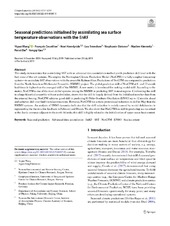| dc.contributor.author | Wang, Yiguo | |
| dc.contributor.author | Counillon, Francois | |
| dc.contributor.author | Keenlyside, Noel | |
| dc.contributor.author | Svendsen, Lea | |
| dc.contributor.author | Gleixner, Stephanie | |
| dc.contributor.author | Kimmritz, Madlen | |
| dc.contributor.author | Dai, Panxi | |
| dc.contributor.author | Gao, Yongqi | |
| dc.date.accessioned | 2020-06-19T15:57:33Z | |
| dc.date.available | 2020-06-19T15:57:33Z | |
| dc.date.issued | 2019-07-23 | |
| dc.Published | Wang Y, Counillon F, Keenlyside N, Svendsen L, Gleixner, Kimmritz M, Dai P, Gao Y. Seasonal predictions initialised by assimilating sea surface temperature observations with the EnKF. Climate Dynamics. 2019;19:5777-5797 | eng |
| dc.identifier.issn | 0930-7575 | en_US |
| dc.identifier.issn | 1432-0894 | en_US |
| dc.identifier.uri | https://hdl.handle.net/1956/22785 | |
| dc.description.abstract | This study demonstrates that assimilating SST with an advanced data assimilation method yields prediction skill level with the best state-of-the-art systems. We employ the Norwegian Climate Prediction Model (NorCPM)—a fully-coupled forecasting system—to assimilate SST observations with the ensemble Kalman filter. Predictions of NorCPM are compared to predictions from the North American Multimodel Ensemble (NMME) project. The global prediction skill of NorCPM at 6- and 12-month lead times is higher than the averaged skill of the NMME. A new metric is introduced for ranking model skill. According to the metric, NorCPM is one of the most skilful systems among the NMME in predicting SST in most regions. Confronting the skill to a large historical ensemble without assimilation, shows that the skill is largely derived from the initialisation rather than from the external forcing. NorCPM achieves good skill in predicting El Niño–Southern Oscillation (ENSO) up to 12 months ahead and achieves skill over land via teleconnections. However, NorCPM has a more pronounced reduction in skill in May than the NMME systems. An analysis of ENSO dynamics indicates that the skill reduction is mainly caused by model deficiencies in representing the thermocline feedback in February and March. We also show that NorCPM has skill in predicting sea ice extent at the Arctic entrance adjacent to the north Atlantic; this skill is highly related to the initialisation of upper ocean heat content. | en_US |
| dc.language.iso | eng | eng |
| dc.publisher | Springer | en_US |
| dc.rights | Attribution CC BY | eng |
| dc.rights.uri | http://creativecommons.org/licenses/by/4.0/ | eng |
| dc.subject | Seasonal prediction | eng |
| dc.subject | Advanced data assimilation | eng |
| dc.subject | EnKF | eng |
| dc.subject | SST | eng |
| dc.subject | NorCPM | eng |
| dc.subject | ENSO | eng |
| dc.subject | Sea ice extent | eng |
| dc.title | Seasonal predictions initialised by assimilating sea surface temperature observations with the EnKF | en_US |
| dc.type | Peer reviewed | |
| dc.type | Journal article | |
| dc.date.updated | 2020-01-14T14:55:57Z | |
| dc.description.version | publishedVersion | en_US |
| dc.rights.holder | Copyright 2019 The Author(s) | en_US |
| dc.identifier.doi | https://doi.org/10.1007/s00382-019-04897-9 | |
| dc.identifier.cristin | 1715484 | |
| dc.source.journal | Climate Dynamics | |
| dc.relation.project | Norges forskningsråd: 270733 | |
| dc.relation.project | Norges forskningsråd: 229774/E10 | |
| dc.relation.project | Nordforsk: 76654 | |
| dc.relation.project | Trond Mohn stiftelse: BFS2018TMT01 | |
| dc.relation.project | Notur/NorStore: NS9039K | |
| dc.relation.project | EU: 648982 | |
| dc.relation.project | Notur/NorStore: NS9207K | |
| dc.relation.project | Notur/NorStore: NN9039K | |
| dc.relation.project | Notur/NorStore: NN9385K | |

